 This page covers the fossils and geology of the stone in 14 buildings in the downtown core of Montreal. It is a very abbreviated version of the Redpath Museum publication What Building Stones Tell, which contains more information, especially on the creatures represented by the fossils, and is in the form of a self-guided walking tour. This booklet is also available in a translated version: Les pierres de construction m'ont raconté...
This page covers the fossils and geology of the stone in 14 buildings in the downtown core of Montreal. It is a very abbreviated version of the Redpath Museum publication What Building Stones Tell, which contains more information, especially on the creatures represented by the fossils, and is in the form of a self-guided walking tour. This booklet is also available in a translated version: Les pierres de construction m'ont raconté...
Each building on the tour features different types of rocks and fossils. You will examine some of North America’s most attractive and interesting rocks dating from a period in the earth’s history more than a billion years ago. The buildings and monuments you will visit are built or faced with stones from the three major rock classes - igneous, sedimentary and metamorphic.
The three kinds of stones
Igneous
Rock formed from cooling and solidification of hot molten material (magma) such as granite or syenite. Individual mineral crystals are easily identified on polished granite surfaces. Some examples of dark coloured igneous rocks are gabbro, gabbroic anorthosite, and anorthosite troctolite.
Sedimentary
Rock produced when particles such as sand are laid down under water (e.g. sandstone) or when fossil corals and shells accumulate to form limestone (e.g. Montreal limestone).
Metamorphic
Rock that has been changed (metamorphosed) by heat and pressure. Under pressure, original features in these rocks are often deformed or partially destroyed. Examples of metamorphic rocks are marble, ironstone, slate and quartzite
Choosing building stones
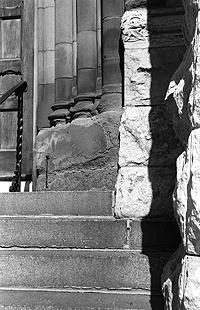
Building stone needs to look attractive and last for many decades, if not centuries. It must be chosen with great care by an expert. The stone must be strong enough to support the building above it and durable enough to withstand attack by rain, sun, organisms, pollution or sea spray. It must be easy to work to avoid excessive cost. The stone must be placed in the building as it was in the quarry so that it is under similar stresses; up-ended or face-bedded sandstone, for example, will tend to flake badly. Finally, incompatible stones like sandstone and limestone would not be placed together, as acid solutions that wash carbonates from the limestone can chemically affect the durability of sandstone.
Fourteen interesting sites in Montreal
 Redpath Museum, 859 Sherbrooke West
Redpath Museum, 859 Sherbrooke West
Built with:
Trenton limestone, a sedimentary rock from the Ordovician of Quebec, about 470 million years old.

What to look for:
On the west side of building, directly across the road from the glass and metal tower, look at the stones at the base of the building, near the centre. What you see is a white shell with fine ribs or raised stripes. This shell is called Rafinesquina alternata and it belongs to a group of animals called brachiopods.
 McGill Faculty Club, 3450 McTavish Street
McGill Faculty Club, 3450 McTavish Street
Built with:
Trenton limestone, a sedimentary rock from Quebec, formed during the Ordovician Period, about 470 million years ago. The red clay bricks on the side wall are made from black shale, another sedimentary rock from the late Ordovician, about 430 million years old.
 Walk along the driveway and look at the red bricks on the side wall. Find the cat’s paws imprinted in the bricks. Is this a fossil? No. When these bricks were made in the La Prairie Brickyards over 100 years ago, the clay was left to dry in moulds rather than being baked in a kiln or fired. Cats walked over the wet bricks and left their paw prints on them.
Walk along the driveway and look at the red bricks on the side wall. Find the cat’s paws imprinted in the bricks. Is this a fossil? No. When these bricks were made in the La Prairie Brickyards over 100 years ago, the clay was left to dry in moulds rather than being baked in a kiln or fired. Cats walked over the wet bricks and left their paw prints on them.
 CIBC Building (Specifically, the CANACCORD Capital monument in front of the building), 1010 Sherbrooke West
CIBC Building (Specifically, the CANACCORD Capital monument in front of the building), 1010 Sherbrooke West
Built with:
Anorthosite from Saint Nazaire, Quebec. It was formed during the Precambrian, about 1 billion years ago.
What is anorthosite?
Anorthosite is a very hard, igneous rock formed from molten material that cooled inside the earth. Anorthosite is rare; it is more common on the surface of the moon than the earth. Anorthosite is known as ‘“Black Cambrian granite” and you will find it used for steps, statues and monuments. It is polished to bring out the colours of the different minerals. Look closely — you will see very dull grey pieces; these are the plagioclases that make up most of the rock. The pink granite that you are walking on is from Finland and is called Rapakivi granite.
 Atholston House, 1172 Sherbrooke West
Atholston House, 1172 Sherbrooke West
Built with:
Trenton limestone, a sedimentary rock from Quebec, formed during the Ordovician Period, about 470 million years ago
What to look for:
In the stone right under the bay window and on the stairway are broken pieces of fossils laid down in layers. This layering is called bedding or stratification. These strata (layers) mark the layers where particles of sand, mud, silt and dead animal shells were deposited by currents and settled on a seabed. About 470 million years ago, when this area was a warm, shallow tropical sea, many different kinds of animals lived here. When they died they fell to the bottom of the sea, slowly building up thick layers or strata. This compressed into a solid mass and formed limestone.
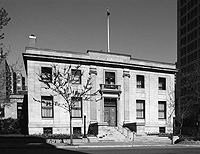 Mount Royal Club, 1175 Sherbrooke West
Mount Royal Club, 1175 Sherbrooke West
Built with:
Trenton limestone, a sedimentary rock from Quebec, formed during the Ordovician Period, about 455 million years ago. The stones on the walls are from the St. Marc Quarry near Quebec City. The bottom or found-ation stones of the building are gray granite from Stanstead, Quebec. They are from the Devonian Period, formed about 285 million years ago.
 What to look for:
What to look for:
On the stone wall by the sidewalk are gastropod molds from the sea snail called Maclurites.
 Holt Renfrew, 1300 Sherbrooke West
Holt Renfrew, 1300 Sherbrooke West
Built with:
Stanstead granite on the base. The walls are made of Indiana limestone from the Bloomington-Bedford area of Indiana. The limestone was formed about 360 million years ago during the Carboniferous Period.
 What to look for:
What to look for:
If you look closely at the walls on the east side of the building going down rue de la Montagne you will see that it is made of many broken pieces of calcite and small disks. These disks are the fossils of ancient crinoids, or “sea lilies”, and the building stone is called encrinal or crinoidal limestone.
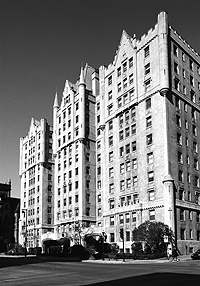 Le Château Apartments, 1321 Sherbrooke West
Le Château Apartments, 1321 Sherbrooke West
Built with:
This building is made of very distinctive Tyndall limestone from the Garson Quarry about 40 km northeast of Winnipeg. This is the same rock that was used to build the Houses of Parliament in Ottawa. This rock was formed during the Ordovician Period, about 470 million years ago.
 What to look for:
What to look for:
All the most exciting fossils can be found on the eastern wall of the building, north of Sherbrooke on rue de la Montagne. You will find astropods, corals and cephalopods.
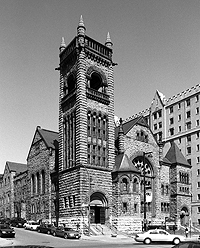 Erskine & American Church, 1339 Sherbrooke West
Erskine & American Church, 1339 Sherbrooke West
Built with:
Three different types of rock: The grey sedimentary stone on the walls is limestone formed during the Ordovician Period. The olive brown bands are Carboniferous Sandstone from the Miramichi region of New Brunswick which was formed about 380 million years ago. The steps and walkways are made of grey granite from Stanstead, Quebec. The weakest rock is made of sand. Look at the base of the tower and notice how the sandstone is wearing away more quickly than the other rocks.
Why is the sandstone wearing down?
Different types of stones can be incompatible when they are used together because they absorb or shed water differently. The sandstone is porous and absorbs moisture easily, which results in it taking more punishment than the limestone when it rains in the summer or freezes in the winter. The sandstone is also stained with black marks and runny patches, the result of minerals that are washed out of the limestone. It reacts to acids, and acid rain eats into the limestone and dissolves minerals within it. These are then absorbed by the porous sandstone beneath as the water washes over it.
 Musée des Beaux-Arts, 1379 Sherbrooke West
Musée des Beaux-Arts, 1379 Sherbrooke West
Built with:
Both buildings are made with Vermont marble from immense underground quarries in the southwest area of the state near Manchester. Called American Carrara, this marble was formed during the Appalachian uplift.
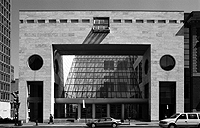 What to look for:
What to look for:
There are no fossils in this building stone because they disappeared during metamorphism, or transformation, of the original limestone into marble. Metamorphism causes changes at the atomic level that alter the look, character and strength of the resulting metamorphic rock. The striped lines in the marble are made of bands of minerals such as muscovite and chlorite: the elements that make up these minerals were present in the original limestone.
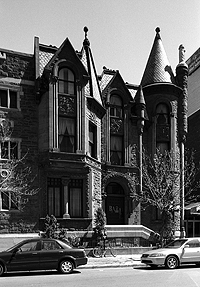 Maison Peter Lyall, 1445 Bishop Street
Maison Peter Lyall, 1445 Bishop Street
Built with:
‘Old Red Sandstone’ from Scotland. This distinctive rock was formed in the Devonian Period, about 260 million years ago. Scottish sandstone or brownstone is uncommon in Montreal. It was used as ballast to stabilize empty ships involved in the fur trade during the 18th and 19th centuries. The base of the building is made of Chazy Formation limestone from Quebec, formed about 450 million years ago.
 What to look for:
What to look for:
In the limestone on the wall to the left of the front steps are little marks that look like broken branches of wood. These are the fossil remains of bryozoans (‘moss animals’). Also note the carved sandstone heads under the windowsills. Most of these carvings are protected by the window ledges but some of them have weathered badly and most of the detail of the face is missing. This weathering is due to the chemical alteration of feldspars to kaolin (clay) under the influence of acid present in snow and rain.
 Dominion Square Building, 1010 Ste. Catherine Street West
Dominion Square Building, 1010 Ste. Catherine Street West
Built with:
Limestone from Rockwood, in northwestern Alabama. This rock was formed in the Mississippian Period, about 300 million years ago. It is more durable than the Indiana limestone found on the walls of the Holt Renfrew building, but both were laid down in warm seas that covered much of North America at the time. The base is grey granite from Stanstead, Quebec.
What to look for:
The walls just inside the door, on the west side, show dark streaks or lines dispersed through the limestone. These are called fracture lines. Fracture lines are breaks or cracks that occurred when the limestone was stretched or squeezed by movements of the earth’s crust. This occurred when the limestone was buried many kilometers below the earth’s surface. Water moved into the cracks carrying metals such as iron. The iron filled the cracks, colouring them as dark streaks and lines. There are no fossils in this limestone.
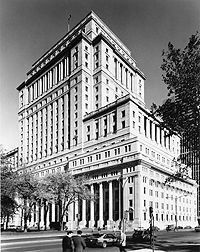 Sunlife Building, 1155 Metcalfe Street
Sunlife Building, 1155 Metcalfe Street
Built with:
The entire building is made of grey granite from Stanstead, Quebec. The interior foyer or entrance is made of marble: the pink variety on the walls and floors is from Tennessee and Italy; the black marble pilasters, or interior columns, are from Belgium. To enter the building to see the foyer, use the first door on Mansfield Street, just north of René Lévesque Boulevard.
What makes the different colours in the marble?
The different colours of marble are caused by tiny amounts of trace elements that are dispersed among the normal rock forming elements. For example, marble starts out as un-metamorphosed limestone. It is made up of the elements calcium, carbon and oxygen. If a trace element such as iron is present, it can rust the limestone when it makes contact with air and water. As the limestone metamorphoses into marble, this natural rust may cause the resulting limestone to be pink, yellow, red or brown. A black colour may be due to the presence of organic matter like bitumen. It doesn’t take a lot of trace element to work its magic—perhaps only a few parts per million.
 Cathédrale Marie-Reine-du-Monde, 1085 rue de la Cathédrale
Cathédrale Marie-Reine-du-Monde, 1085 rue de la Cathédrale
Built with:
Limestone formed in Quebec during the Ordovician Period, about 470 million years ago. The capitals at the top of the columns on the west side (closest to rue de la Cathédrale) have been restored with Chazy Limestone from Isle LaMotte, Vermont, in Lake Champlain.
What to look for:
Three very clear pockets of bryozoan colonies can be found weathered out of one block on the right hand side of the main door. Bryozoans or ‘moss animals’ are small creatures that built communal skeletons made up of tiny tubes or chambers. They are totally different from corals, both in the more complex structures of their zooids and in details of their skeletons. Bryozoans lived on or near coral reefs and were very common in the Ordovician sea. Today there are over 4000 living species of bryozoans.
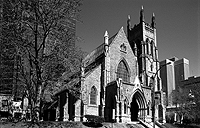 St. George’s Anglican Church, 1101 Stanley Street
St. George’s Anglican Church, 1101 Stanley Street
Built with:
Chazy Formation limestone on the walls, Ohio sandstone on the gables and colonnets. The roof is made of purple slate from Nut Cove, Newfoundland. The slate began as mud—particles of pre-existing rocks that were transported by water and deposited into the deep water of an ancient ocean. The sediments were re-worked by ocean currents to produce a fine-grained mud which was then compacted over millions of years to produce shale. Approximately 400 million years ago, the shale was metamorphosed into slate by the heat and pressure of folding during the formation of the Appalachian Mountains.
What to look for:
On the window casing on Stanley Street are small pockets of solitary (rugose) corals in sandstone. In solitary corals, the external appearance of the fossil is a horn-shaped corallite. The shape of the fossil shows that as the animal or polyp grew, its corallite expanded and started to curve.
